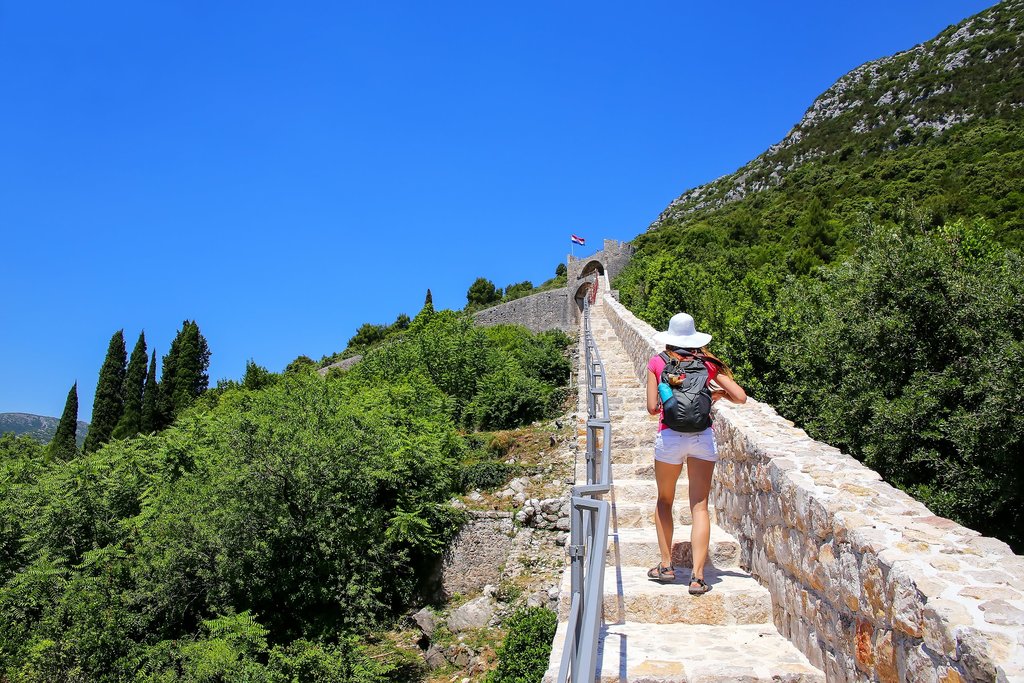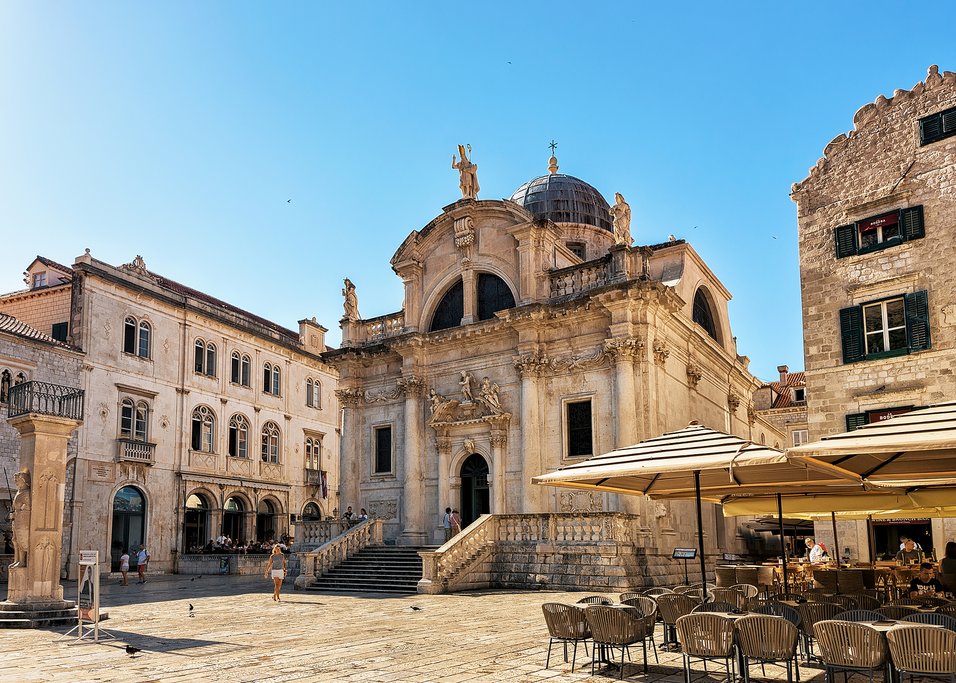Highlights
- Marvel at Split's ancient stone sphinxes brought back from Egypt 3,500 years ago
- Spend a day on the Adriatic as you sail amid the Pakleni Islands
- Cycle across Korcula, stopping to sample local wines endemic to the island
- Drink Dingac and explore Ston's impressive stone walls and glittering saltpans
- Take in a sunset over the Elafiti Islands from atop Dubrovnik's Srd Mountain
Brief Itinerary
| Day | Highlights | Overnight |
|---|---|---|
| Day 1 | Arrive in Split | Split |
| Day 2 | Historical Walking Tour of Split | Split |
| Day 3 | Ferry to Hvar, Sunset Sea Kayaking Tour | Hvar Town |
| Day 4 | Sail the Pakleni Islands Archipelago | Hvar Town |
| Day 5 | Ferry to Korčula, Cycling & Wine Tasting in Lumbarda | Korčula Town |
| Day 6 | Transfer to Ston via Pelješac Peninsula | Ston |
| Day 7 | Morning in Ston, Transfer to Dubrovnik | Dubrovnik |
| Day 8 | Historical Walking Tour of Dubrovnik | Dubrovnik |
| Day 9 | Depart Dubrovnik |
Detailed Itinerary
Day 1: Arrive in Split, Explore

From the airport, it's a short (45-minute) drive to the center of Split. Depending on your arrival time, check into your hotel and take the rest of the day to explore the historic port city on your own.
Founded 1,700 years ago by Roman emperor Diocletian, Split's Old Town consists of a number of impressive sites, including Peristyle, Cathedral of St. Dominus, and Diocletian's Palace, one of the best-preserved Roman buildings in the world. Start in Peristyle Square, taking in the 3,500-year-old sphinxes Diocletian brought back from Egypt before exploring the 4th-century complex. From there, pass through the Iron Gate and into Pjaca Square for pretty views of white marble tiles, a Romanesque clock tower with the remains of a medieval sundial, and the 15th-century Town Hall.
In the evening, take a stroll along Split's seafront Riva to admire the waterfront views before finding the off-beat Konoba Dioklecijan restaurant, just to the left of the Bronze Gate for a bite to eat, its outdoor terrace built into the walls of Diocletian's Palace.
Day 2: Historical Walking Tour of Split

Meet your expert guide in Peristyle Square for a walking tour, taking in the 3,500-year-old sphinxes Diocletian brought back from Egypt before exploring the 4th-century Diocletian's Palace and other noteworthy sites.
If there's time following your tour, climb the Romanesque bell tower of the Cathedral of St. Dominus (St. Duje)—considered the oldest Catholic cathedral still in use—for stunning views over the city and Adriatic. Another option for great views is to hike or bike to the top of Marjan Hill. Referred to as the "lungs of the city," the entire Marjan peninsula is dotted with tiny centuries-old churches, large cypress and black pine trees, and Mediterranean plants and herbs.
In addition to the stunning vistas, you'll be rewarded with attractions less visited: the Jewish cemetery and 13th and 15th-century churches, St. Nicholas and St. Jerome, respectively. Afterward, head to Bačvice Beach and relax on the sand warmed by the day's sun before choosing a nearby restaurant for dinner.
Day 3: Ferry to Hvar, Sunset Sea Kayaking Tour

This morning you'll catch a ferry from Split to Hvar and check into your hotel. A Croatian island in the Adriatic Sea, Hvar is a popular destination with tourists due to its natural setting, mild climate, and its historic town of the same name. You'll have the late morning to explore Hvar Town. Visit St. Stephen's Cathedral and climb the steps to the terrace outside of the historic Arsenal to enjoy views over the harbor and the surrounding area.
In the afternoon, pack your swimwear and towel and head to Hvar Town's beachfront for your guided sunset kayaking tour to the nearby Pakleni Islands. The islands are the most beautiful part of the Hvar Riviera and are a favorite retreat for locals seeking to escape the summer heat. Altogether, there are 14 wooded and rocky islets, which you will get a chance to explore by kayak with a striking pink sky as a backdrop.
Ferry time: 1.5-2 hours
Chat with a local specialist who can help organize your trip.
Day 4: Sail the Pakleni Islands Archipelago

Today you'll spend a full day enjoying the sun and sea on a sailing boat. In the morning, join your group sailing adventure and depart the port in Hvar Town to venture out to the Pakleni Islands, just off the coast of Hvar. The trip will include two stops, one for a swim and snorkel and the other for a picnic lunch on board before returning to Hvar Town in the afternoon. This is the perfect opportunity to admire one of the best views of the town, its café, and yacht-filled harbor, the nearest thing Croatia has to the Côte D'Azur Riviera.
The name Pakleni originates from the days when the islands were the main source of resin for local shipbuilders (from paklinski to mean 'resin'). The islands are the most beautiful part of the Hvar Riviera, offering the best beaches, and are a favorite retreat for locals seeking to escape the summer heat.
Day 5: Ferry to Korčula, Cycling & Wine Tasting in Lumbarda

Onward to Korčula! Once on the island, you'll transfer to your hotel in Korčula Town to settle in, drop off your luggage, and meet your guide to join a wine-tasting cycling tour across the island. Pick up your bike, and with your guide, you'll head to the Lumbarda region on the southeastern tip of the island. You'll ride through fields, villages, and wineries, covering asphalt, gravel, and dirt roads with vistas opening up to the Adriatic Sea as well as to the impressive Mount Ilija on the nearby Pelješac Peninsula.
This gentle route explores the ancient and historic sites of the eastern side of the island as you work your way to the spread-out village of Lumbarda. Boasting beautiful beaches and centuries-old winemaking traditions, the village of Lumbarda is home to grk, a white grape variety that will pair well with your lunch or dinner. Some of Croatia's best white wines are produced on Korčula, and you won't be left wanting.
You'll also have the opportunity to visit Bire Winery, a family-run winery that produces grk wine as well as its own varietals, including a rosé. All the wineries in the area produce grk, which is unique to this region due to its sandy soil and plavac mali (a red grape grown extensively across South Dalmatia that acts as a pollinator for the Grk vines).
Spend some time relaxing on one of Lumbarda's beaches before returning to Korčula Town. You'll have the rest of the afternoon to discover this little island's numerous restaurants, taverns, shops, and bars as you roam the maze of gray stone houses, alleys, churches, and squares.
Ferry time (Hvar to Korčula): 1.5 hours
Cycling tour duration: 3-5 hours
Day 6: Transfer to Ston via Pelješac Peninsula

Make your way to the ferry terminal in either Korčula Old Town (foot passengers) or nearby Dominče (car ferries) to transfer the short distance to Orebić on the Pelješac Peninsula. Wander the seaside town's narrow streets, noting the charming stone villas once occupied by famous sea captains. From here, you'll continue your journey southeast to your hotel in the medieval city of Ston, stopping to sample Dingač, Croatia's most well-known red at any of the numerous vineyards populating the rugged landscape.
If there's interest, rent a bike and cycle along the Plavac Mali vineyards to a quiet bay for a swim, snorkel, and lunch break before carrying on to Ston, the twin settlement to Mali Ston on the opposite end of the peninsula's isthmus. End the day with a meal of Ston's famous fresh oysters or mussels accompanied by a glass of local Dingač.
Ferry time (Korčula to Orebić): 30 minutes
Driving time (Korčula to Ston): 1 hour
Day 7: Morning in Ston, Transfer to Dubrovnik

Take the better part of the day to explore Ston, its surroundings, and of course, its impressive fortified walls—the longest on the continent (originally built to keep predators away from the town's saltpans) and discover the importance this area held in the 14th century. Enjoy beautiful views over the Adriatic and Ston and its glittering saltpans—one of the oldest and still active in the Mediterranean—from a parapet walkway.
Rent a kayak and paddle amid oyster and mussel farms in Ston's Bay, taking in the striking views of the walls from the sea. Alternatively, if you're looking for more of a beach day, find your way to Prapratno, just over a mile away, for access to the peninsula's largest sandy beach.
When it's time, make your way to your accommodation in the historic coastal fortress city of Dubrovnik. The remainder of the day will be at your leisure, allowing time for you to wander and explore the city. Climb the 16th-century city walls for incredible views of countless red rooftops of old stone houses, towers, turrets, churches, and palaces. And be sure to find your way to the limestone-paved Stradun, Dubrovnik's main street, to get your bearings and choose from some of Croatia's best restaurants and wine bars.
Driving time (Ston to Dubrovnik): 1 hour
Day 8: Historical Walking Tour of Dubrovnik

Start your day early (around 8 am) to avoid the crowds and embark on a tour of Dubrovnik, where you'll meet your expert guide outside the entrance to the medieval city at the 16th-century Pile Gate. Entering Old Town, you'll uncover centuries of the city's rich history as you listen to stories of local life and legends and of the importance Dubrovnik once held in the era of the Republic. Highlights include Onofrio's Fountain, the 15th-century Rector's Palace, Luza Square, the Church of St. Blaise (St. Vlaho), and the café-lined streets of Brsalje Street.
After touring the streets and alleys, you'll head for Lovrijenac Fortress as well as the city's impressive defensive walls, the second-largest set of city walls in the world. At certain places, the wall rises 75 feet high, offering excellent vantage points for photos of the coastline.
For the rest of the afternoon, explore Dubrovnik and its surroundings on your own or enjoy the afternoon sun on the nearby beaches. You might want to come early evening so that you can see the stunning panoramic views over the city and Adriatic by taking the cable car up to Srđ Mountain before descending back down for dinner at one of Dubrovnik's great restaurants.
Day 9: Depart Dubrovnik

Depending on when you depart, you may have time to visit one of Dubrovnik's museums, like the Franciscan Monastery and Museum. This large complex houses many treasures, including the world's third-oldest pharmacy dating from 1317.
Alternatively, for a collection of 15,000 pieces of interesting works, visit the Rector's Palace and Cultural Historical Museum. Wander this well-preserved palace-turned-museum and explore its exhibits, some detailing life in the Republic of Ragusa during medieval times. The drive to the airport from Dubrovnik takes around 45 minutes with normal traffic.
More Great Croatia Itineraries
Looking for more inspiration for your trip to Croatia? Check out these other Croatia itineraries, explore different ways to spend nine days in Croatia, or discover the best time to visit Croatia.
